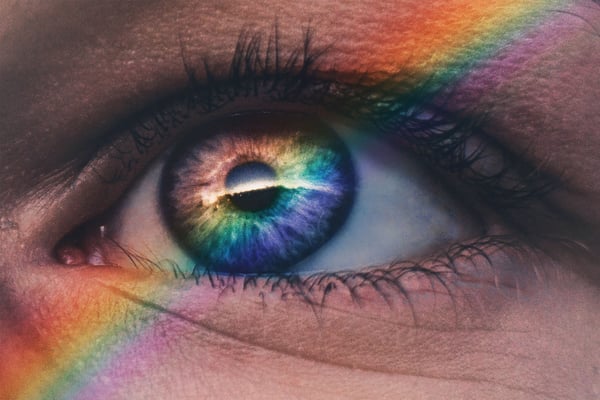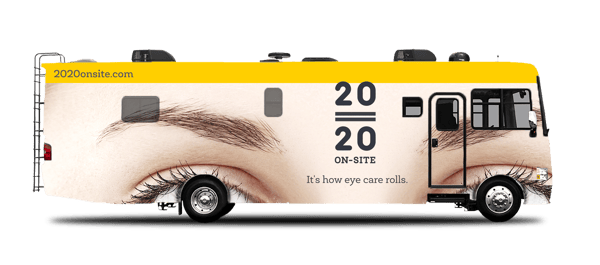
Photo by Harry Quan on Unsplash
You probably already know that most babies are born with blue eyes, and the color settles into its permanent tint by about a year of age. But in what other ways do your eyes change as you get older?
THE FIRST YEAR
At birth, babies' primary focus is on objects 8 to 10 inches from their face or the distance to parent's face. During the first months of life, the eyes start working together and vision rapidly improves.
For the first two months of life, an infant's eyes are not well coordinated and may appear to wander or to be crossed. This is usually normal. However, if an eye appears to turn in or out constantly, an evaluation is warranted. Babies should begin to follow moving objects with their eyes and reach for things at around three months of age.
Five to eight months
At around the fifth month the eyes are capable of working together to form a three-dimensional view of the world and begin to have depth perception.

Photo by Colin Maynard on Unsplash
Although an infant's color vision is not as sensitive as an adult's, most babies have good color vision by five months of age. This is a good time for a baby’s first eye checkup, which can usually be done in the pediatrician’s office. If there are signs of problems, a referral to an eye specialist is in order.
Nine to twelve months
Babies can now judge distances fairly well and throw things with precision, as any parent will tell you.
SCHOOL AGE
Every child needs to have certain vision skills for effective reading and learning. These include:
Visual acuity—the ability to see clearly in the distance for viewing the chalkboard, at an intermediate distance for the computer, and up close for reading a book.
Eye Focusing—the ability to quickly and accurately maintain clear vision as the distance from objects change, such as when looking from the chalkboard to a paper on the desk and back.
Eye tracking—the ability to keep the eyes on target when looking from one object to another, moving the eyes along a printed page, or following a moving object like a thrown ball.
Eye teaming—the ability to coordinate and use both eyes together when moving the eyes along a printed page, and to be able to judge distances and see depth for class work and sports.
Eye-hand coordination—the ability to use visual information to monitor and direct the hands when drawing a picture or trying to hit a ball.
Visual perception—the ability to organize images on a printed page into letters, words and ideas and to understand and remember what is read.
If any of these visual skills are lacking or not functioning properly, a child will have to work harder. This can lead to headaches, fatigue and other eye strain problems. Parents and teachers need to be alert for symptoms that may indicate a child has a vision problem.

Photo by Les Anderson on Unsplash
Most schools have eye screening programs, but they may miss certain issues. It makes sense to have a “real” eye exam with an opthamologist or optometrist sometime during grammar school (ages 5-12.)
Children who need eyeglasses or contact lenses should be examined annually or as recommended by their optometrist or or opthamologist.
ADOLESCENCE AND YOUNG ADULTHOOD

Photo by Anika Huizinga on Unsplash
Many kids start needing prescription eyewear in their teens, mainly because this is a prime time for the development of nearsightedness, a.k.a. the inability to see objects at a distance. This, again, is prime time for an eye exam, and the beginning of the habit of seeing an eye doctor yearly.
LATER ADULTHOOD
Just as our physical strength decreases with age, our eyes also exhibit an age-related decline in performance—particularly as we reach our 60s and beyond.
Some age-related eye changes are perfectly normal and don't signify any sort of disease process. Some, however, will experience more serious age-related eye diseases that have greater potential for affecting quality of life. These conditions include glaucoma and macular degeneration.
Presbyopia. After you pass the milestone age of 40, you'll notice it's more difficult to focus on objects up close because of presbyopia, a perfectly normal loss of focusing ability due to hardening of the lens inside your eye.
For a time, you can compensate for this gradual decline in focusing ability by holding reading material farther away from your eyes. But eventually you will need reading glasses, progressive lenses or multifocal contact lenses.
As you continue to age through your 50s and beyond, you may notice the need for more frequent changes in eyeglass or contact lens prescriptions. You may also find that a single prescription is no longer the best solution for all your visual needs. As an example, you may need one pair of eyeglasses for normal tasks and another that emphasizes intermediate ranges for working more comfortably at the computer.
Cataracts. Even though cataracts are considered an age-related eye disease, they are so common among seniors that they can also be classified as a normal aging change.
According to the Mayo Clinic, about half of all 65-year-old Americans have some degree of cataract formation in their eyes.
As you enter your 70s, the percentage is even higher. It's estimated that by 2020 more than 30 million Americans will have cataracts.
Modern cataract surgery is extremely safe and so effective that 100 percent of vision lost to cataract formation is usually restored. If you are noticing vision changes due to cataracts, don't hesitate to discuss symptoms with your eye doctor. It's often better to have cataracts removed before they advance too far. Also, you do have options for trying multifocal lens implants or accommodating intraocular lenses that potentially can restore all ranges of vision, thus reducing your need for reading glasses.
Major Age-Related Eye Diseases
- Macular degeneration. Also called age-related macular degeneration or AMD, this condition is the leading cause of blindness among American seniors.
- According to the National Eye Institute (NEI), more than two million Americans currently have age-related macular degeneration, and due to the aging of the U.S. population, that number is expected to more than double by 2050.
- Glaucoma. Your risk of developing glaucoma increases with each decade after age 40, from around 1 percent in your 40s to up to 12 percent in your 80s. The number of Americans with glaucoma will increase by 50 percent (to 3.6 million) by 2020.
HOW AGING AFFECTS OTHER EYE STRUCTURES
While we normally think of aging as it relates to conditions such as presbyopia and cataracts, more subtle changes in our vision and eye tructures also take place as we grow older. These changes include:
- Reduced pupil size. As we age, muscles that control our pupil size and reaction to light lose some strength. This causes the pupil to become smaller and less responsive to changes in ambient lighting. Because of these changes, people in their 60s need three times more ambient light for comfortable reading than those in their 20s.
- Also, seniors are more likely to be dazzled by bright sunlight and glare when emerging from a dimly lit building such as a movie theater. Eyeglasses with photochromic lenses and anti-reflective coating can help reduce this problem.
- Dry eyes. As we age, our bodies produce fewer tears. This is particularly true for women after menopause. If you begin to experience a burning sensation, stinging, or other eye discomfort related to dry eyes, use artificial tears as needed throughout the day for comfort, or consult your eye doctor for other options such as prescription dry eye medications.
- Loss of peripheral vision. Aging also causes a normal loss of peripheral vision, with the size of our visual field decreasing by approximately one to three degrees per decade of life. By the time you reach your 70s and 80s, you may have a peripheral visual field loss of 20 to 30 degrees.
- Decreased color vision. Cells in the retina that are responsible for normal color vision decline in sensitivity as we age, causing colors to become less bright and the contrast between different colors to be less noticeable. In particular, blue colors may appear faded or "washed out." While there is no treatment for this normal, age-related loss of color perception, you should be aware of this loss if your profession (e.g. artist, seamstress or electrician) requires fine color discrimination.
- Vitreous detachment. As we age, the gel-like vitreous inside the eye begins to liquefy and pull away from the retina, causing "spots and floaters" and (sometimes) flashes of light. This condition, called vitreous detachment, is usually harmless. But floaters and flashes of light can also signal the beginning of a detached retina—a serious problem that can cause blindness if not treated immediately. If you experience flashes and floaters, see your eye doctor immediately to determine the cause.
WHAT YOU CAN DO ABOUT AGE-RELATED VISION CHANGES
A healthy diet and wise lifestyle choices, such as not smoking, are your best natural defenses against vision loss as you age. For ideas on improving your eye diet, see our blog, How to Eat for Your Eyes.

Be sure to discuss with all concerns you have about your eyes and vision with your eye doctor. Tell him or her about any history of eye problems in your family, as well as any other health problems you may have.
Your eye doctor should know what medications you take (including non-prescription vitamins, herbs and supplements). This will help with appropriate recommendations to keep your eyes healthy and functioning at their optimum level throughout your lifetime.
Also, at any age, you need to have regular eye exams with a caring and knowledgeable optometrist or ophthalmologist. Think of us, 2020 On-site--we bring eye care directly to your workplace, and 97% of the more than 30,000 people who’ve used our service say that they’d recommend us to others and would use us again. Contact us for more information.
To see what an exam with us is like, check out our brief (and fun) patient experience video. We think you’ll like what you see.



